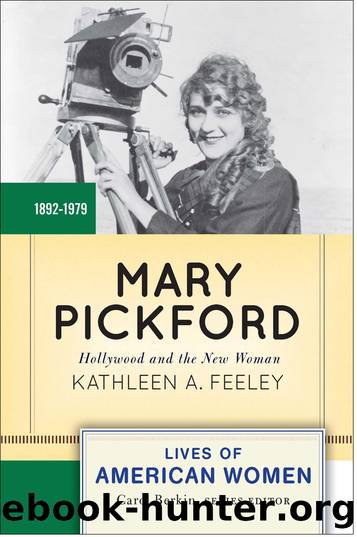Mary Pickford by Kathleen A. Feeley

Author:Kathleen A. Feeley
Language: eng
Format: epub
ISBN: 9780813348063
Publisher: Westview Press
Published: 2016-01-11T00:00:00+00:00
5
Mary and Doug: American Royalty, Hollywood Style, 1920â1926
Pickford and Fairbanksâs 1920 working European honeymoon and the hyperbolic media coverage thereof meant that they returned to a US press and public prepared to overlook their extramarital liaison and embrace their compelling and lucrative partnership. âIt is one of the great love stories of all time,â declared Photoplay, the most important film fan magazine of the day, reflecting a decisive shift in media coverage and public sentiment.1 Social acceptance and celebration of their marriage was illustrative of broader changes in the legal and social structure of American matrimony, particularly as women achieved the vote in August 1920 and made other economic and political gains. The Pickford-Fairbanks pairing was just one example of high-profile personal and professional partnerships that proliferated in early Hollywood. Such duosâwhich included actress/producer Norma Talmadge and her husband, producer Joseph Schenckâhelped to both facilitate and legitimize female ambition and power. Indeed, marriage to Fairbanks aided in reconciling the traditional and unconventional in Pickfordâs image and life. No longer was she the female cohead of the Pickford family: now she had a powerful, new husband to assume the long-absent role of patriarch.
Pickford had worried that her divorce and remarriage might cause a scandal and tarnish her name and reputation. Her fears were not unfounded: the movie industry had for almost two decades been a target of social reformers and elites concerned about the changes wrought in US society by industrialization, urbanization, and immigration. In the postwar period, a moral panic was building around the âevil in the moviesâ stemming from many âracially, morally, idealistically foreignâ sources. Rising postwar tides of xenophobia and racism fueled anti-Semitic charges of âJewish motion picture controlâ as well as fears that Americans, especially girls and women, were being corrupted by film content and industry employment. The private lives and personal conduct of industry personnel would shortly erupt as a topic of national debate and condemnation. And the Pickford family would be drawn into the conflict and tragedy, but it was the end of Jackâs as opposed to Maryâs marriage that fueled speculation and outrage.2
Pickford and Fairbanksâs love story exemplified the newly emergent twentieth-century ideal of the companionate marriageâa more equitable partnership in which romantic and sexual love figured prominently alongside other economic, social, and political considerations. In a preindustrial Anglo-American context, the patriarchal, productive household was a fundamental economic and political unit in which the male head of household wielded nearly absolute power over household members: wives, children, servants, and slaves. With the rise of industrial capitalism and its mass consumer economy, the patriarchal household was modified by companionate marriage, which offered wives greater economic, political, and social autonomy. Divorce also became more easily obtained and socially acceptable. Yet men retained much of their political privilege and economic and legal dominance within the white, heterosexual Christian, monogamous union. Being part of such a union with the influential Fairbanks who performed an exuberant masculinity onscreen and off helped Pickford maintain her role as Americaâs Sweetheart. Throughout
Download
This site does not store any files on its server. We only index and link to content provided by other sites. Please contact the content providers to delete copyright contents if any and email us, we'll remove relevant links or contents immediately.
| Actors & Entertainers | Artists, Architects & Photographers |
| Authors | Composers & Musicians |
| Dancers | Movie Directors |
| Television Performers | Theatre |
Cecilia; Or, Memoirs of an Heiress — Volume 2 by Fanny Burney(31875)
Cecilia; Or, Memoirs of an Heiress — Volume 3 by Fanny Burney(31858)
Fanny Burney by Claire Harman(26530)
We're Going to Need More Wine by Gabrielle Union(18973)
Plagued by Fire by Paul Hendrickson(17335)
All the Missing Girls by Megan Miranda(15595)
Cat's cradle by Kurt Vonnegut(15190)
Bombshells: Glamour Girls of a Lifetime by Sullivan Steve(13979)
Leonardo da Vinci by Walter Isaacson(13189)
For the Love of Europe by Rick Steves(13103)
4 3 2 1: A Novel by Paul Auster(12290)
Adultolescence by Gabbie Hanna(8859)
The remains of the day by Kazuo Ishiguro(8830)
Note to Self by Connor Franta(7622)
Diary of a Player by Brad Paisley(7488)
Giovanni's Room by James Baldwin(7199)
What Does This Button Do? by Bruce Dickinson(6137)
Born a Crime by Trevor Noah(5302)
Ego Is the Enemy by Ryan Holiday(5297)
